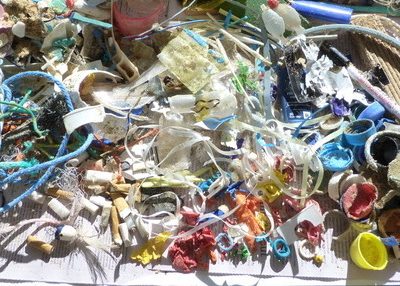Observations from a long time marine debris collector.

As with most other Australian Coastal Society members, I have been a salt water person for as long as I can remember, back to being taken to South Cronulla Beach as a two or three year old. While not academic or professional, I did pass Coastal Geomorphology at UNSW which I thoroughly enjoyed way back in the early 1970’s. Since then, I have been an active volunteer in coast and wetland management, and whether walking, surfing or swimming, I have collected marine debris.
In February 2014, I collected a bunch of helium balloons from my local beach that had travelled overnight from Albury to south of Bermagui. As I had been regularly asking the NSW state government to ban the release of balloons, it spurred me on to do more.
As a result of enquires, I became involved in submitting data to the Australian Marine Debris Initiative. Instead of just throwing each morning’s 1100 metre beach walk collection into the bin when I arrive home, I now save it and at the end of each month, tally up the various sorts of debris, mainly plastics, hard and soft, as well as fishing gear, and of course balloons.
The beach borders a national park and has no stormwater outlets or urban area. It has an ICOLL at each end of the beach, one a lake, the other a smaller lagoon. The lagoon opens to the sea less often than the Lake.
One thing has become very clear. The debris quantity is dependent on weather. A few days after rain, with several days of bigger swells and on-shore winds, the debris increases significantly. Larger, heavier pieces arrive in the first day or two, and smaller pieces, down to micro-plastics (less than 5 mm) in the days after as the swell subsides. Urban sources can only be Bermagui in north-easterly swells and wind or Tathra and Merimbula in south-easterly conditions.
The fire at Tathra in March was fanned by strong north-westerly winds, and burnt vegetation was washed ashore after a few days of south-easterly wind.
Another determinant in the season. There is more debris in summer compared to winter, perhaps due to increased boating activity and more visitors to the area.
School holidays brings another source. An increase in beach users see more general rubbish left behind. Visitors apparently enjoy going to a natural beach with no sign of humans, only to leave their lolly and chip wrappers, drink containers, cigarette butts and of course fishing gear behind.
Fishing gear has diminished a little over the years. I collect fewer plastic bait bags but still collect a huge number of pieces of rope, apparently discarded by commercial fishers, along with lost cyclume sticks. I always wonder what sort of chemicals have entered the ocean when I find a broken cyclume stick.
Cigarette butts are usually associated with bait fishers, standing in the same spot, either dropping them where they stand or tossing their butts into the ocean which then spits them back out further along the beach.
Occasionally I have collected pieces of a foam tray, spread out along several hundred metres of shoreline. The pieces can fit together.
One of the more interesting items was a 30 kg bag of garlic. I hauled it out of the surf zone to dry out, only for it to disappear several days later. Presumably someone ’enjoyed’ salt infused garlic.
A couple of 20 and 30 litre water containers, with new caps, are now used by the dune care group for plantings. While other material has been reused, repurposed or recycled, most ends up in landfill.
Balloons continue to be an issue. Using the AMDI, I know I collected 260 balloons – whole, burst or remnant – in 28 reports from just 1100 metres of beach (2014 – 2016). The AMDI estimates over 22,500 balloons were found around Australia in the year to September 2017 from beaches covered by the marine debris collections. Who knows how many more are threatening wildlife, littering the oceans or inland areas. The campaign to ban the release of balloons and the use of helium to inflate balloons is another story.
Meanwhile, with global attention on ocean pollution, the state and territories are starting to take variable action on marine debris. A national approach would be welcome.
Some notes from my collecting are below, click on the link to see the photos
Highest personal tally of micro-plastics, April 2018 (over 300 pieces) – Image 1
Rain, sustained big swell and on-shore winds result in a bigger monthly tally. April 2018 – Image 2
Less garbage in winter except for July when school holidays sees an increase in beach litter, as opposed to marine – Image 3
Just one balloon will end up as litter – Image 4
Single balloons add up to many – Image 5
Last time the Lake opened to the sea, June 2016 – Image 6 Almost the same position, November 2018 – Image 7
Karen Joynes ACS Member
Words by ACS Member, Karen Joynes. Please respect the author’s thoughts and reference appropriately: (c) ACS, 2018, posted 2 December 2018, for correspondence about this blog post please email austcoastsoc@gmail.com


 Backbarrier flats – a relic coastal landform
Backbarrier flats – a relic coastal landform